Bibliometric analysis of the global research status and trends of mechanotransduction in cancer
2023-12-18YiZhanZhangMengZhuLiGuangXinWangDaWeiWang
Yi-Zhan Zhang,Meng-Zhu Li,Guang-Xin Wang,Da-Wei Wang
Abstract BACKGROUND The development of cancer is thought to involve the dynamic crosstalk between the tumor cells and the microenvironment they inhabit.Such crosstalk is thought to involve mechanotransduction,a process whereby the cells sense mechanical cues such as stiffness,and translate these into biochemical signals,which have an impact on the subsequent cellular activities.Bibliometric analysis is a statistical method that involves investigating different aspects (including authors’ names and affiliations,article keywords,journals and citations) of large volumes of literature.Despite an increase in mechanotransduction-related research in recent years,there are currently no bibliometric studies that describe the global status and trends of mechanotransduction-related research in the cancer field.AIM To investigate the global research status and trends of mechanotransduction in cancer from a bibliometric viewpoint.METHODS Literature on mechanotransduction in cancer published from January 1,1900 to December 31,2022 was retrieved from the Web of Science Core Collection.Excel and GraphPad software carried out the statistical analysis of the relevant author,journal,organization,and country information.The co-authorship,keyword cooccurrence,and keyword burst analysis were visualized with VOSviewer and CiteSpace.RESULTS Of 597 publications from 745 institutions in 45 countries were published in 268 journals with 35510 citation times.With 270 articles,the United States is a well-established global leader in this field,and the University of California system,the most productive (n=36) and influential institution (n=4705 citations),is the most highly active in collaborating with other organizations.Cancers was the most frequent publisher with the highest H-index.The most productive researcher was Valerie M.Weaver,with 10 publications.The combined analysis of concurrent and burst keywords revealed that the future research hotspots of mechanotransduction in cancer were related to the plasma membrane,autophagy,piezo1/2,heterogeneity,cancer diagnosis,and post-transcriptional modifications.CONCLUSION Mechanotransduction-related cancer research remains a hot topic.The United States is in the leading position of global research on mechano-oncology after almost 30 years of investigations.Research group cooperations exist but remain largely domestic,lacking cross-national communications.The next big topic in this field is to explore how the plasma membrane and its localized mechanosensor can transduce mechanical force through post-transcriptional modifications and thereby participate in cellular activity regulations and cancer development.
Key Words: Bibliometric analysis; Mechanotransduction; Cancer; Visualization; Signal transduction
INTRODUCTION
Cancer is a devastating disease characterized by the transduction of abnormal cell signals,which leads to oncogenic cellular behaviors such as uncontrolled proliferation and resistance to death[1].According to the latest statistics,cancer is the second most common cause of death worldwide after cardiovascular disease[2].Therefore,it is crucial to determine the pathogenesis of this disease so that effective therapeutic approaches can be identified.Although cancer is primarily regarded as being a genetic disease caused by the stepwise accumulation of gene mutations,an increasing number of studies suggest that environmental factors might also have a significant influence on the development of this disease[3].The tumor microenvironment (TME) consists of cancer-associated fibroblasts (CAFs),endothelial cells,immune cells,and the extracellular matrix (ECM),and together these provide the biochemical and mechanical signals required to stimulate the occurrence,survival,and development of cancer[4].While the importance of biochemical stimuli (such as small molecules,growth factors,and cytokines) in cancer progression is well-established,the role of mechanical force is still relatively underexplored although recent investigations suggest that it is on par with the chemical factors[5-7].
In cancerous tissues,mechanical forces such as shear stress,tension,and compression,are suggested to be generated during cell-TME and cell-cell contact events[8].These forces are then translated into biochemical signaling cascades with the help of various mechanoreceptors,including G protein-coupled receptors,ion channels,and cell junction proteins[9,10].This process of transducing specific mechanosignals into distinct intracellular biochemical signals is called mechanotransduction[5].Abnormal mechanical signals (generated by the environment or cells),can alter the expression of genes and transduction of signaling pathways.This leads to the dysregulated cell behaviors that are associated with many diseases,including cancer[11].For example,when compared with normal tissues,cancerous tissues have a more rigid ECM,which contributes to the aberrant mechanotransduction observed[12].This leads to an increase in the expression of many oncogenic transcription factors (such as YAP/TAZ,Twist1,and β-catenin),which enhances cell proliferation,the epithelial-mesenchymal transition (EMT),and/or cell migration in cancer cells[13].Interestingly,YAP/TAZ has also been reported to contribute to tissue stiffness by increasing the expression of the crucial ECM modifiers,CTGF and CYR61[14-17].Therefore,a positive mechanotransductive feedback loop between cancer cells and the ECM is regarded as one of the major culprits for cancer malignancy[17].In addition,when cancer cells are surrounded by a rigid,crosslinked ECM,then this impedes immune cell invasion and drug distribution,which leads to immune surveillance escape and drug resistance[6,18].
The concept of mechanotransduction also helps to explain the mechanisms of cancer initiation,invasion,and metastasis from a new perspective.Considering the fundamental role of mechanotransduction in cancer development,researchers are now developing new cancer therapeutics based on the specific mechanical properties of and mechanosignal transducers generated by tumors.For example,Simtuzumab and Simvastatin,which reduce ECM stiffness and inhibit YAP/TAZ hyperactivation,respectively,have been evaluated for their anti-cancer efficacy in preclinical studies[18-20].Mechanotransduction is therefore already showing great promise for clinical applications,and so further comprehensive investigations in this field will likely reveal more therapeutic strategies for cancer treatment.Thus,gaining a better understanding of the current research status of mechanotransduction in cancer is likely to shed light on important research questions and directions for future study.
Bibliometric analysis is a useful quantitative method to comprehensively analyze publications from many different aspects (including the authors and their affiliations,journal title and article keywords),to reveal collaborative networks and emerging trends in specific research areas[21-23].Although increasing numbers of research papers now focus on the role of mechanotransduction in cancer,to date,no bibliometric analysis has been conducted to quantify the situation.To this end,here we present the updated bibliometric analysis of research conducted on mechanotransduction in cancer and reveal the current research being conducted in this field.In this way,we aim to provide a better understanding of the present status of this study area and predict key topics of future investigation in this promising research field.
MATERIALS AND METHODS
Searching strategies
We retrieved literature on ‘mechanotransduction in cancer’ research from the Web of Science Core Collection (WoSCC).The publication period was set from January 1,1900 to December 31,2022,and only English publications were included.The search strategy is illustrated in Figure 1.All recorded data,including the authors’ names,institutions,and countries,as well as keywords,were downloaded from the WoSCC and normalized to a standard format.To avoid ambiguity,we cross-checked duplicate authors among the documents.Meeting abstracts,editorial materials,corrections,and retractions were excluded from our research.
Keyword analysis
The keywords were extracted from the keyword section of articles.To avoid potential deviations,similar or same keywords with different expressions were manually standardized to correct and/or group similarities as previously suggested[23-25],before VOSviewer or CiteSpace analysis.Burst keywords were assessed using CiteSpace (V6.2R4 SE)with the following parameters: time slicing (from January 1994 to December 2022),years per slice (1),node type(keyword),the minimum burst duration (1 year),γ (0.39) and others (default).A keyword co-occurrence analysis was conducted with VOSviewer (version 1.6.18) with the following parameters: Type of analysis (co-occurrence),unit of analysis (keywords),counting method (full counting),minimum number of occurrences of a keyword (3).
Data visualization
The number of publications and citations in the indicated time was presented using GraphPad Prism 8.Visualization of bibliometric information,including co-authorship analysis,keyword co-occurrence,and burst analysis,was conducted with VOSviewer (version 1.6.18) and CiteSpace (V6.2R4 SE).
RESULTS
General information
A total of 597 publications comprising 388 research and 209 review articles,were extracted for deep analysis.Although the concept of mechanotransduction was established progressively from the 1950s to the 1980s[26-28],the first paper describing mechanotransduction in cancer was only published in 1994[29].Since then,this topic has gradually gained more attention from researchers in the cancer research field.Based on the number of publications and citations analysed in our bibliometric study on mechanotransduction-related cancer research,we prepared a growth curve comprising three clear stages.The first stage described the period from 1994 to 2010,during which time <10 papers were published each year.In the second stage,which ran from 2012 to 2017,a slow growth rate was observed,and in the third stage (2018-2022),the growth rate started to accelerate,with almost 100 articles being published in the final year (Figure 2A).
In the 597 articles that were published,there was an average of 59.48 citations per paper.The top 10 most cited papers included six reviews and four research articles;these are listed in Supplementary Table 1 and they are ranked by the number of times they were cited.The most highly cited review article (n=2882 citations) was published by Chamberset al[30],and the most highly cited research article (n=1021 citations) was contributed by Aragonaet al[31].
During our exploration of mechanotransduction in cancer,we sub-divided the publications into 56 research categories to indicate the multidisciplinary crossovers that occurred.After the top 10 categories were generated (Figure 2B),we found that cell biology (n=191),oncology (n=130),and biochemistry molecular biology (n=117),accounted for 73.37%of all the publications.This indicates that molecular cytology is a key contributor to research on the role of mechanical force in cancer development.

Figure 1 The strategy we used to search for publications about mechanotransduction in cancer. 597 publications closely correlated with mechanotransduction in cancer were extracted based on this strategy.
Analysis of countries and institutions
Although a total of 45 countries was found to contribute publications on the topic of mechanotransduction in cancer,the top 10 most productive countries generated 87.6% of all the papers.Of these,the United States was the most productive as it was responsible for 270 (i.e.,45.23%) of the publications.China (n=119,19.93%) and Italy (n=41,6.87%) held the second and third positions,respectively,but both lagged behind the United States (Table 1).However,when we ranked the countries in terms of the average citation times,Canada occupied the first place with an average of 197.33 citations per paper.This was followed by Italy and Spain with values of 109.17 and 93.09,respectively.In addition,according to this ranking approach,the United States (73.74 times) held a middle position,whereas China (20.34 times) was at the bottom of the ranking list.To evaluate the cooperation between different countries,a co-authorship network was established with a criterion of at least three publications in each country.As shown in Figure 3,the United States (with the most extended research history in this field),collaborated most with other countries,followed by the United Kingdom.In addition,it was interesting to find that although 37.78% (i.e.,17/45) of the countries only published one or two papers,most of this work was conducted in the recent five years.This indicates that more countries are stepping into this research field.
Our data analysis also showed that 745 organizations were involved in research related to mechanotransduction in cancer.After ranking these according to the number of publications,we found that the top 10 organizations accounted for 35.85% (214/597) of all papers.The University of California system ranked first with 36 articles,and this was followed sequentially by UDICE-French Research Universities (n=27),Centre National de la Recherche Scientifique (n=25),the University of Illinois system (n=21),and Institut National de la Sante et de la Recherche Medicale (Inserm).It was striking to find that three institutions from France occupied three of the top five positions with a total of 31 publications(Table 2).Another analysis of the global inter-institutional network showed that the University of California system collaborated most with other organizations,followed sequentially by the University of Padua,Harvard University,and University College London (Figure 4).
Analysis of journals and authors
Articles related to the field of mechanotransductive cancer research were distributed among 268 different academic journals.The top 10 journals to publish papers in this field accounted for 22.61% (135/597) of all the articles(Supplementary Table 2),but 162 journals (60.45%) only published one paper in this research area.Cancersranked first with 29 (4.86%) publications,followed by theInternational Journal of Molecular Sciences(n=20,3.35%) and theJournal of Cell Science(n=17,2.85%).
We also found that a total of 3001 authors contributed to these 597 publications.After analyzing the top 10 authors in terms of the number of papers (Supplementary Table 3),we found that Valerie M.Weaver from the University of California system was the most productive researcher withn=10 publications.She was followed by Stefano Piccolo from the University of Padua (n=9),Antonios Gargalionis from the National &Kapodistrian University of Athens (n=9),and Marc D.Basson from John D.Dingell Veterans Affairs Medical Center (n=8).Notably,according to the total (T) and average (A) citation times of the papers generated from each author,Stefano Piccolo (T=3167;A=351.89),Tito Panciera(T=2076,A=296.57),Valerie M.Weaver (T=2495,A=249.5),Michelangelo Cordenonsi (T=1983,A=330.5),and Patricia J.Keely (T=1478,A=246.33) ranked the top 5,indicating that they were in positions of authority.To investigate if there were any collaborations between the various authors in this field,an authorship network analysis was performed by identifying those with at least three publications.As shown in Figure 5,the authors were distributed into 43 clusters,with 4 clusters containing at least ten authors.This indicates that there were partial connections between the different groups in this research area.
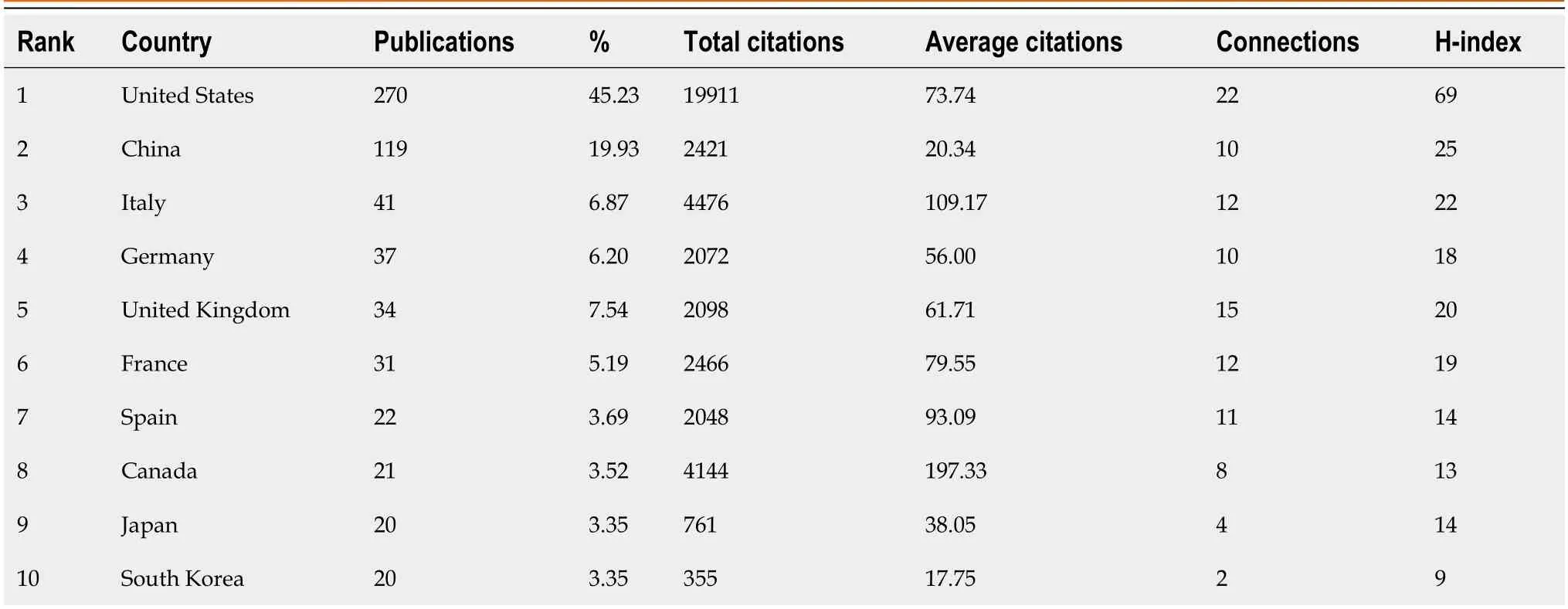
Table 1 The top 10 productive countries that published papers about mechanotransduction in cancer

Table 2 The top 10 productive organizations publishing papers about mechanotransduction in cancer
Keyword analysis
To explore the current research themes and discover hot topics in mechanotransduction-related cancer research,we acquired 666 keywords by collating those with the same meaning or category from all 597 papers.Among them,the top 4 co-occurrent keywords that were consistent with our research topic,were: Mechanotransduction,cancer,mechanical force,and mechanical property.However,when these keywords were restricted to at least 3 co-occurrences,only 93 items could satisfy this criterion.We next established a network based on these 93 keywords and found that they could be further subdivided into eight clusters (Figure 6A and Supplementary Table 4).We found that 19 keywords were included in cluster 1 (red) as follows: Angiogenesis,cadherin,caveolin,cell death,endothelial cell,epithelial cell,growth factor/receptor,hypoxia,integrin,invadopodia,mitogen-activated protein kinases/extracellular signal-regulated kinase(MAPK/ERK),mechanical force,matrix metalloproteinases (MMPs),mechanistic target of rapamycin (mTOR),NF-κB,phosphatidylinositol 3-kinase/protein kinase B (PI3K/AKT),plasma membrane,signal transduction,and traction force microscopy.Cluster 2 (green) also contained 19 items.These were: AMP-activated protein kinase,cell cycle,cell morphology,cytoskeleton or cytoskeleton remodeling,epigenetic regulation,gene regulation,heterogeneity,lamin,linc complex,mechanotransduction,metabolism,microfluidics,migration,nuclear envelope,nuclear mechanics,nucleoskeleton,nucleus,pancreatic stellate cell,and SRC.Cluster 3 (blue) contained the following 16 items: Calcium,cancer,DNA damage,dormancy,immunology,invasion,ion channel,mechanobiology,metastasis,motility,oxidative stress,piezo1/2,post-translational modification,SRF,stem cell,and TRP.Cluster 4 (yellow) contained 11 items: 3D culture,autophagy,cancer diagnosis,cancer stem cell (CSC),drug resistance,hydrogel,immunotherapy,organoid,programmed cell death protein 1/programmed cell death ligand 1,pharmacology,and polycystin.Cluster 5 (purple) contained 8 items:Atomic force microscopy,CAF,ECM or ECM remodeling,mechanical property,oncophysics,therapy,TME,and tumor model.Cluster 6 (cyan) contained 8 items: Contact inhibition,G protein-coupled receptor (GPCR),growth,Hippo,polarity,TAZ,transcription factor,and YAP.Cluster 7 (orange) contained 7 items: Catenin,EMT,fibrosis,noncoding RNA,transforming growth factor-beta (TGF-β),transcription,and Wnt,and cluster 8 (brown) had 5 items: Adhesion,focal adhesion kinase (FAK),mechanical microenvironment,morphogenesis,and RhoA/Rho/ROCK.These grouped keywords were further marked according to the average publication year to reflect their yearly development.Figure 6B shows that the keywords in clusters 1 and 8 were mainly labeled in purple,suggesting that they appeared relatively early on in this field.In contrast,there were more keywords labeled in yellow in clusters 4 and 5,indicating that the topics in these two clusters gained more attention in recent years.Of note,some keywords exhibited a relatively late mean publication year and low mean frequency of occurrence,and so we suggest that these might be the next big topics to be investigated in this area.These include “plasma membrane [average appearing year (AAY)=2021.00]”,“autophagy(AAY=2021.00)”,“piezo1/2 (AAY=2021.17)”,and “heterogeneity (AAY=2021.25)”.
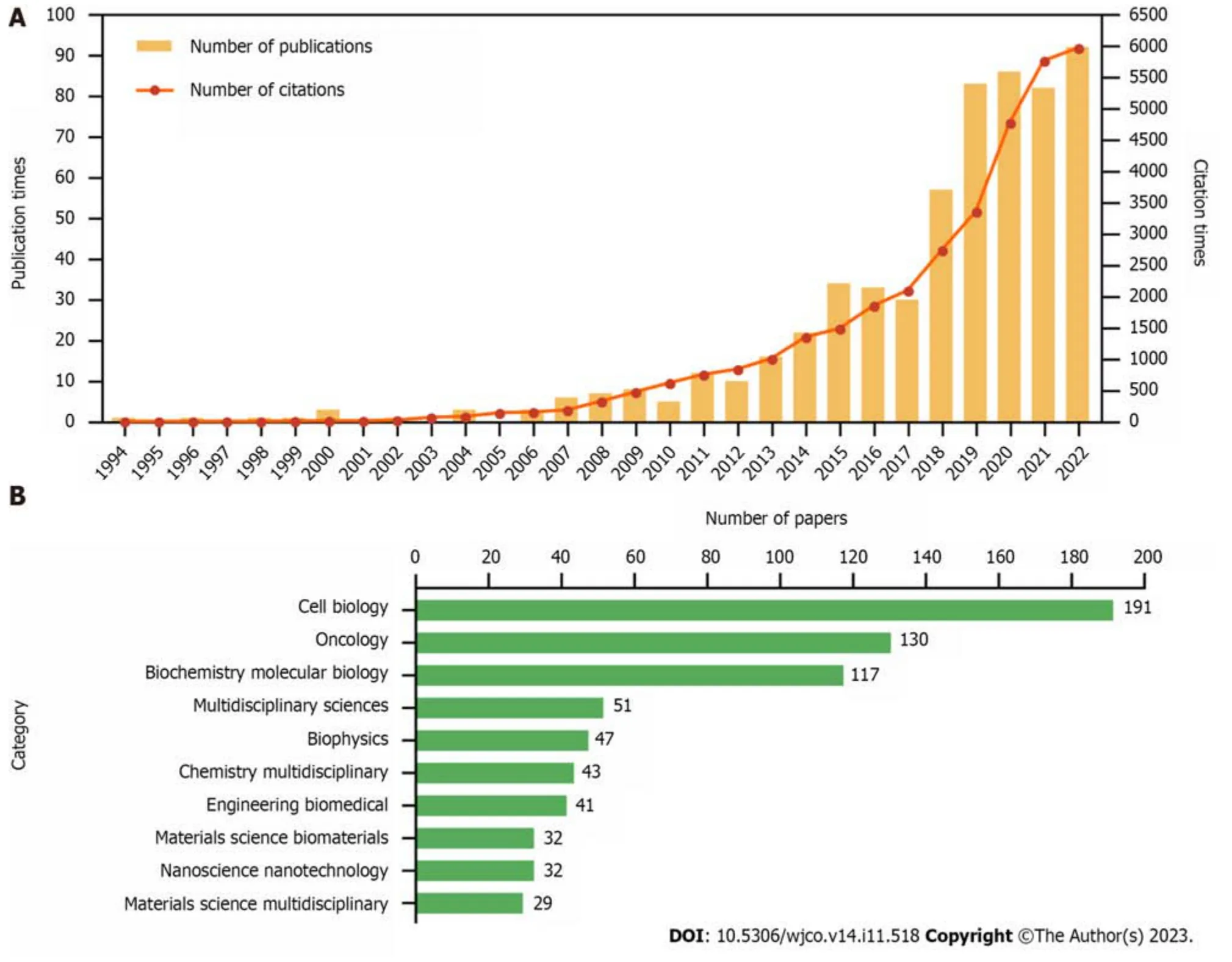
Figure 2 Trends and categories of publications about mechanotransduction in cancer. A: The annual number of publications and citations from 1994 to 2022;B: The research categories of publications related to mechanotransduction in cancer.
In addition to our analysis of co-occurring keywords,a burst keyword analysis (which identifies keywords that were frequently used over a certain period),was carried out with the CiteSpace software.We found that “mechanical force”was the most potent keyword;this appeared in 2006 with a burst strength of 3.99.In addition,the longest burst duration occurred for “signal transduction” (with a burst strength of 2.19);this started in 2004 and lasted for 9 years.Apart from these two keywords,“cancer diagnosis”,“post-transcriptional modification” and “plasma membrane” were shown to have the highest more recent burst time (Figure 6C),indicating possible new research topics in mechanotransductionassociated cancer studies.
DISCUSSION
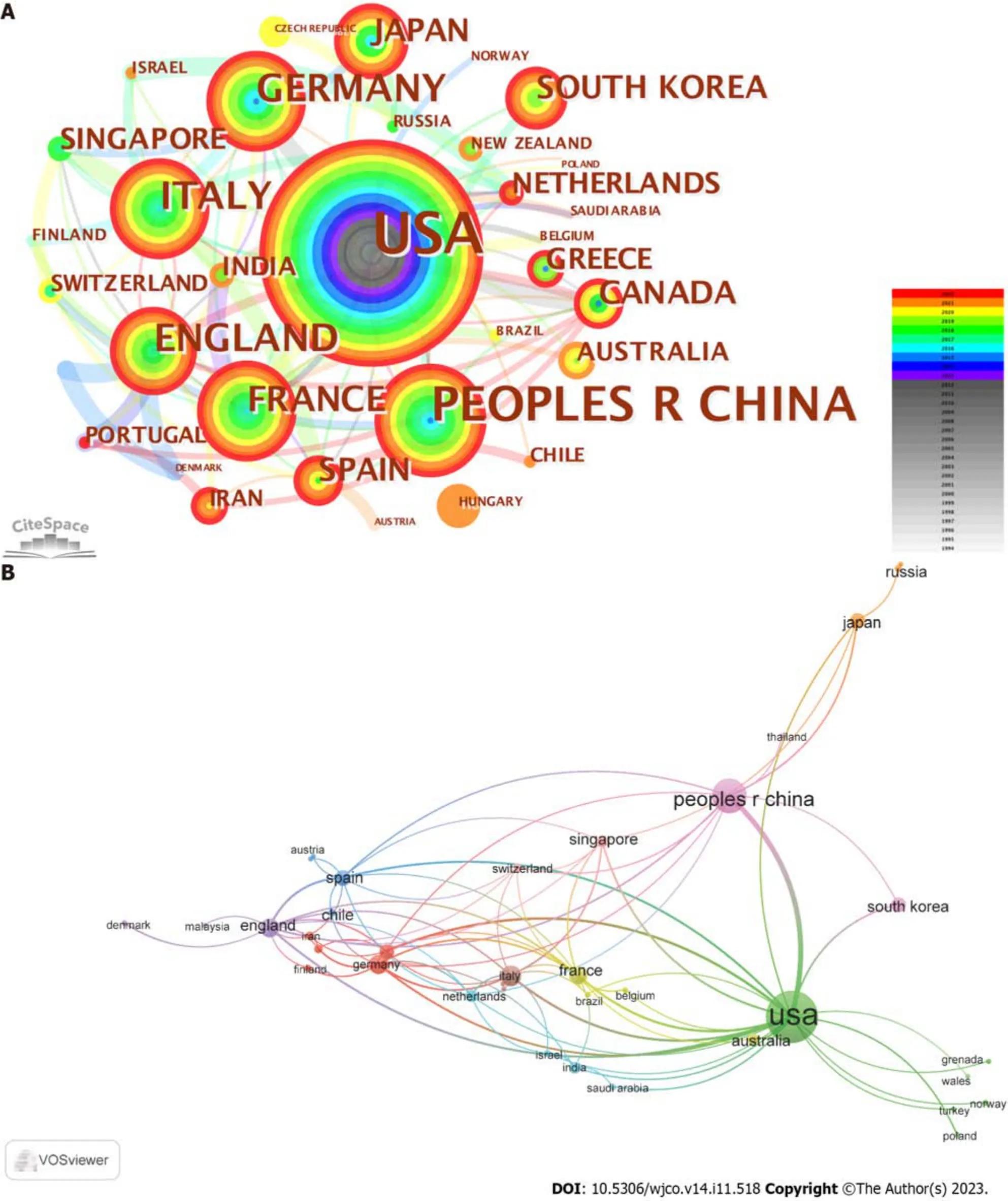
Figure 3 Analysis of countries working on mechanotransduction in cancer. A: CiteSpace was used to conduct the cooperation network between countries.The number of publications is represented by the node size and the different publication years are indicated by the different colors;B: VOSviewer was used to visualize the cooperation between country network.The number of publications is represented by the size of the node and the connection strength is indicated by the line thickness.
The concept of mechanotransduction developed gradually between the 1950s and 1980s as researchers studied how stretching forces influenced membrane depolarization in excitable cells such as nerves[26-28].The fact that mechanotransduction might play a role in cancer was first suggested in 1994,and since then it has helped to explain many puzzles in the cancer research field[29].However,compared to biochemical signal transduction,the role of mechanotransduction in cancer development was largely overlooked from 1994 to 2006.The field then gradually received more attention,and more than 40 papers were published between 2006 and 2016,probably due to the boom in research on the Hippo pathway[32].Notably,there was then a slight reduction in the number of publications in 2017,followed by a substantial increase in 2018.Since then,this field has become far more popular among cancer researchers,such that in the last three years,>80 papers were published per year.As the number of publications increased,so did the number of times that the publications were cited.Indeed,the average citation time reached 59.48 citations per paper,suggesting the high quality of research conducted in this field.Furthermore,Drs David Julius and Ardem Patapoutian were awarded the 2021 Nobel Prize in Physiology or medicine for their work on mechanosensitive ion channels[33].Therefore,this might encourage more groups to conduct mechanotransduction-related cancer research.
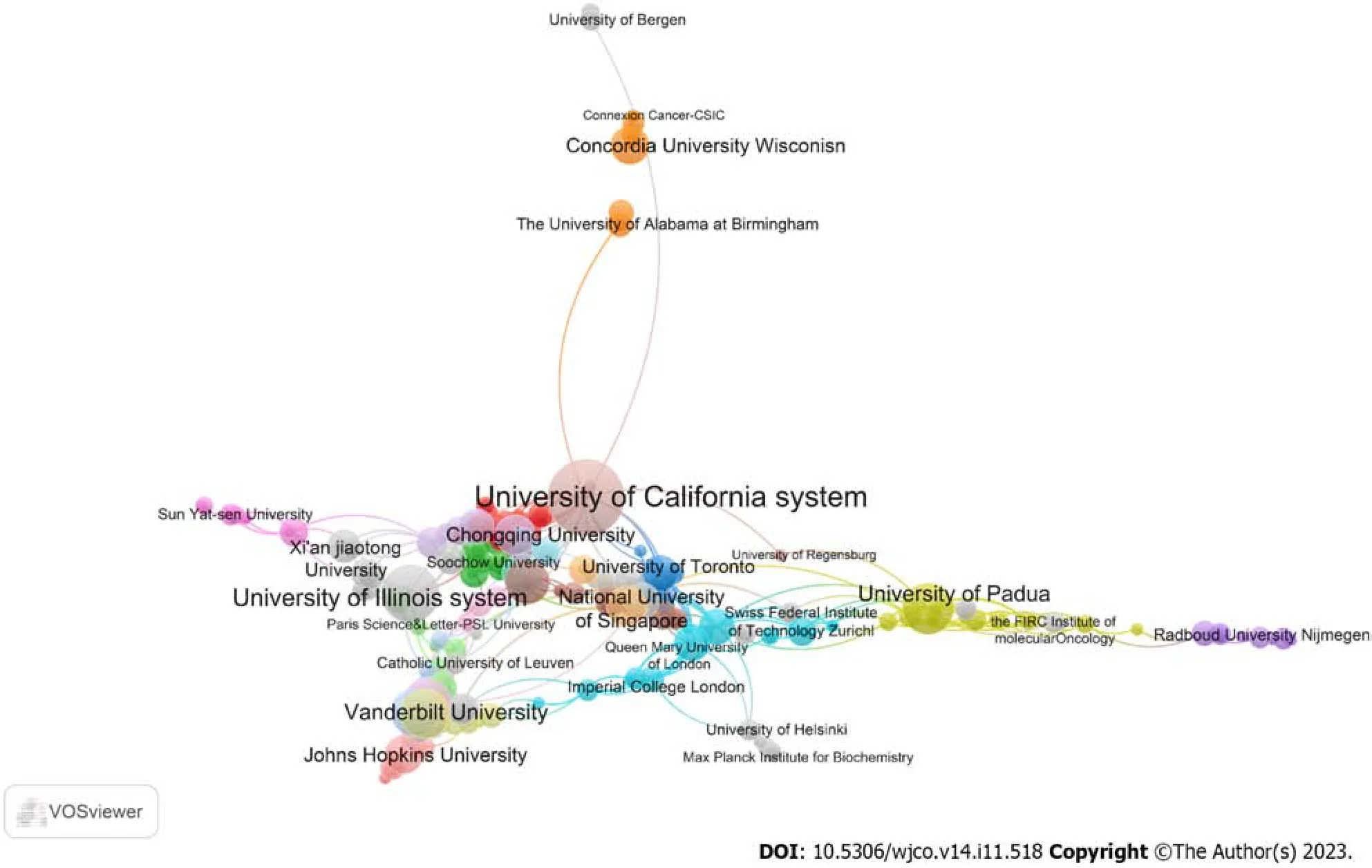
Figure 4 Network analysis of organizations. The collaboration between organizations was analysed with VOSviewer.
By ranking the top 10 productive countries in this area,we found that all except China are advanced countries.The United States has established the lead position of global research on mechano-oncology after nearly 30 years of investigations.However,the number of publications from China indicates that they are in a catch-up position,although the average citation time for their papers is still relatively low.This might be due to the relatively low quality of the publications so far,even though the quantity is high.In addition,the low number of publications in the past from China and the more recent fast growth rate might inherently overly inflate the contribution of highly cited papers to the average citation time.To address this phenomenon,the Chinese government should provide more financial and political support for this research field and encourage original research.For Chinese scholars,discovering new research frontiers as early as possible and carrying out in-depth research is indispensable for improving their international influence and academic standing.It is also important to note that although Canada published 21 articles and is ranked only eighth according to the number of publications,it has the highest average citation rate.One reason for this might be that a review paper published by a Canadian oncology group (Chamberset al[30]),systematically describes the role of mechanical factors on the various physiological stages of cancer metastasis,and this attracts the highest citation frequency in this field.
We also found that cooperations existed between each country,with China and the United States having the most exchanges and collaborations.At the institutional level,we found that cooperations existed in developed countries such as the United States,France,and the United Kingdom.However,in other countries mutual partnerships tended to be insufficient,especially in undeveloped countries,including China.In addition,although several connections between different research groups were found on our authorship network map,these group cooperations largely remained domestic,lacking cross-national communications.Furthermore,three of the top productive and influential scientists in this field (i.e.,Valerie M.Weaver,Stefano Piccolo,and Antonios Gargalionis),have relatively few collaborations with other researchers.The study of mechanotransduction in cancer not only requires an in-depth exploration of molecular mechanisms but also necessitates a large number of clinical samples or populations for clinical validation or translation.At this point,inter-country or inter-institutional collaboration should be advocated,either by sharing clinical databases or by dividing the project into concrete tasks based on the respective expertise.With this approach,significant breakthroughs in this field might be achieved at the earliest time.In addition to collaboration between research groups,interdisciplinary collaborations are also essential for a research field to flourish.Mechanotransduction-related cancer research involves various different disciplines,including biology,physics,and medicine,and so interdisciplinary exchanges are beneficial for the diversity of research and to create new perspectives and questions.For example,in vivomechanosensing is based on force-dependent protein deformation and reorganisation[34].However,due to a lack of molecular resolution in cellular imaging techniques,the intracellular mechanisms are unknown.Recently,with the development of super-resolution microscopy and molecular force sensors,it is now possible to gain molecular insights into mechanosensing in living cells[35].Moreover,the development of novel imaging techniques has helped to advance our knowledge of the molecular mechanisms involved in mechanotransduction[36].
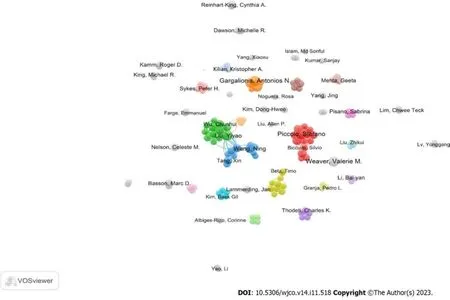
Figure 5 Visualization of author cooperation. VOSviewer was used to visualize the co-authorship network.The clusters are indicated by the different colors and the lines represent the various collaborations between authors.
The 597 papers we found were published in almost 300 journals.This suggests that this field is widely recognized by publishers.Notably,some highly prestigious and influential journals,such asNature,Cell,andCancer Cell,have accepted relevant articles in recent years,which indicates that this research direction is significant and holds great potential for future investigations.We also found that there was a positive correlation between the average number of times that papers published in the top 10 most productive journals were cited,and the impact factor of the journal.This reflects the vibrancy and attractiveness of this research field.However,except for theProceedings of the National Academy of Science of the United States of AmericaandCancer Research,we found that most of these journals such asCancersandInternational Journal of Molecular Sciencesare less highly qualified;therefore,more in-depth explorations are required in the future.
Eight clusters were enriched through a keywords co-occurrence analysis.Cluster 1,with 19 keywords,appeared to elucidate the mechanisms of tumor angiogenesis from the viewpoint of mechanotransduction.Indeed,by providing oxygen and nutrition,tumor angiogenesis,which is initiated by vascular endothelial cell activation,is one of the most fundamental factors for tumor growth and metastasis[37,38].Hypoxia and growth factors plus their receptors (including vascular endothelial-derived growth factor/vascular endothelial-derived growth factor receptor and fibroblast growth factor/fibroblast growth factor receptor) are known to induce endothelial cell proliferationviavarious signal transduction pathways such asviahypoxia-inducible factor-1,PI3K/Akt/mTOR,MAPK/ERK,integrin,and NF-κB signaling[39,40].In addition,MMPs facilitate endothelial cell invasion by degrading the surrounding ECM components[41,42].As well as these biochemical pathways,the shear force of the blood flow and stiffness of the tumor tissues are also considered to be essential parameters that influence angiogenesis by regulating endothelial (tip and stalk) cell migration and vessel stabilization[43,44].For example,it has been demonstrated that caveolin-1 and caveolae act as mechanosensors to respond to altered shear forces for endothelial cell stimulation[45,46].The mechanical forces exerted on cells can be measured using traction force microscopy,and so this technique might help researchers discover more plasma membrane-localized mechanosensors during angiogenesis[47,48].
Clusters 2 and 3 emphasize the molecular mechanisms of mechanotransduction in cancer metastasis from the perspective of cytoskeletal and nucleoskeletal remodeling,and ion channels,respectively.During metastasis,cancer cells detach from the site of the primary tumor.They then migrate and invade the surrounding microenvironments,and after intravasation into vessels and escaping immune surveillance,they seed and colonize distant sites[49].As essential initial steps during metastasis,the migration and invasion processes subject cancer cells to different mechanical forces.These are generated due to contact with the TME,and are characterized by increased solid stress,fluid pressure,and tissue stiffness when compared with their counterparts in normal tissue[17].Although the rigid TME imposes compressive stress on migrating cancer cells,which can cause DNA damage,these mechanical forces can in turn activate the DNA repair system,which limits genotoxicity and maintains regular cellular activity[50].Various ion channels,such as TRP,polycystin,and piezo1/2,are involved in this process as mechanosensors.For example,in the presence of membrane tension,TRP or piezo1/2 undergo conformational changes,which leads to their activation and an influx of extracellular Ca2+[51-53].Such alterations in the Ca2+influx often result in cytoskeleton rearrangements,which directly affect downstream signaling by changing the affinity of cytoskeletal protein binding and regulatory proteins[54].Then,with the assistance of the linker of the nucleoskeleton and cytoskeleton complex,the mechanical forces are transferred to the nucleoskeleton,which distorts the nuclear envelope,impacts the epigenetic state and regulates gene expression[55].
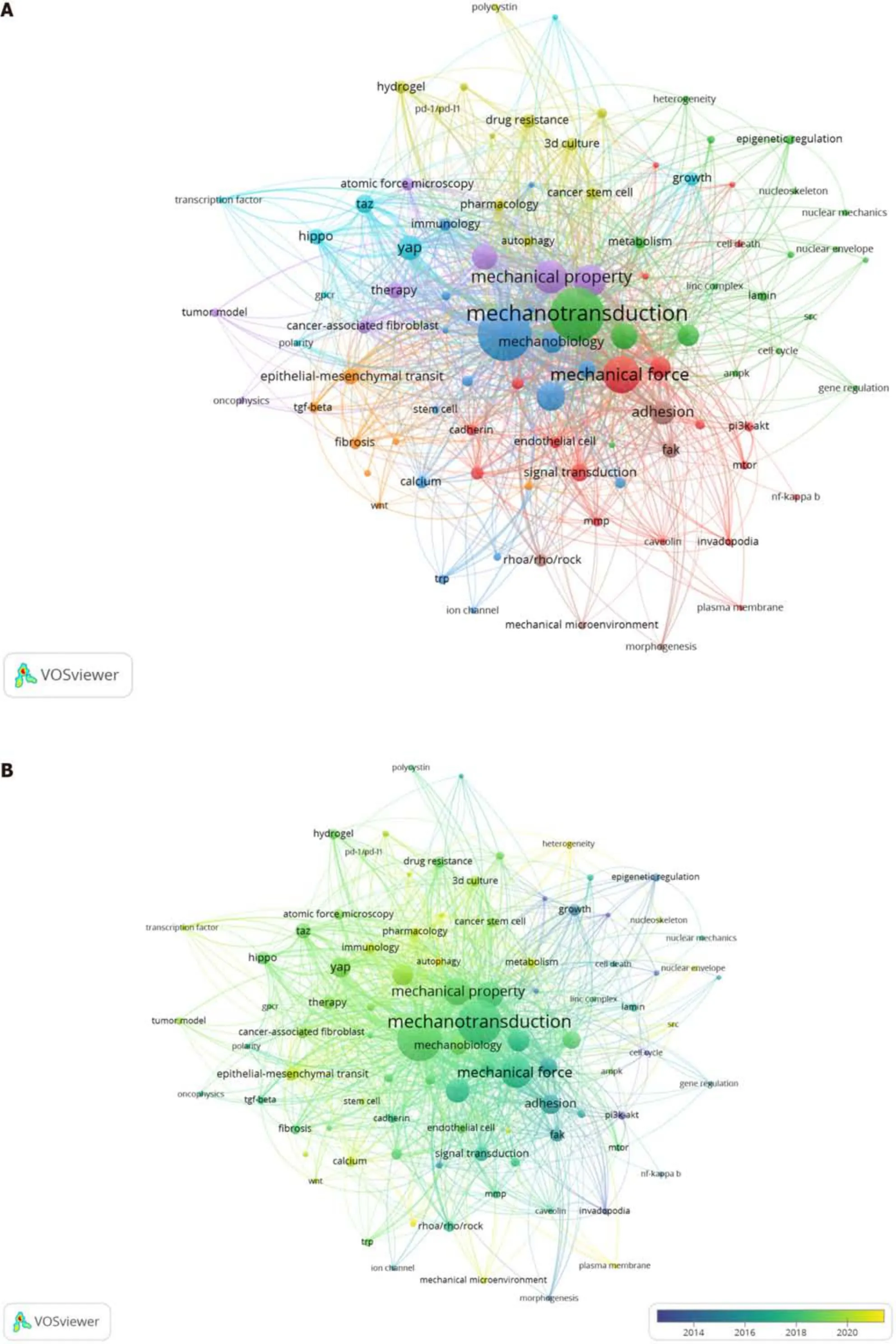
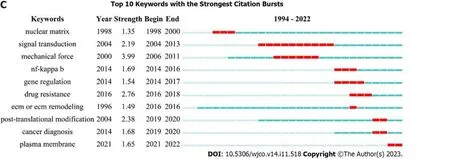
Figure 6 Keyword co-occurrence and burst analysis. A: VOSviewer was applied in our keyword co-occurrence analysis.The colors indicate different clusters and the node size indicates the number of publications;B: A keyword overlay was visualized with VOSviewer.The circle size reflects the number of publications and the average published year is shown by different colored circles;C: CiteSpace was used to conduct the keyword burst analysis.The red rectangles represent the duration of a keyword.
Clusters 4 and 5 highlight the contributing factors that determine the mechanical properties during cancer progression and so these might be useful for the development of relevant pharmaceutical interventions and therapeutical applications.CSCs are the main culprits for the heterogeneity of cancer as they are responsible for cancer initiation,invasive front formation,and drug resistance.It is suggested that the mechanical forces induced by the dense ECM might activate the autophagy and Hippo pathways to promote CSC proliferation and stemness[56,57].Thus,an alternative explanation for the generation of heterogenous CSC populations (except for their intrinsic differences) might be that the heterogenous TME exerts differential mechanical forces on these cells[58].CAFs are a key component of the TME in most solid tumor tissues,and the secretomes that originate from these cells contribute to the formation of the ECM[59].During cancer development,CAFs and cancer cells secrete proteolytic enzymes,cytokines,growth factors,and/or other ECM components,which result in high ECM deposition and increased stiffness[60].The upregulation of programmed cell death ligand 1 under these stiffer ECM conditions enables cancer cells to evade the immune system;a characteristic that is positively correlated with increased malignancy[61].As expected,these unique cancer ECM characteristics have already been applied to cancer diagnosis[62].The three-way biochemical and mechanical crosstalk between CAFs,cancer cells,and the ECM facilitate the remodeling of the latter.The resulting altered mechanical properties of the ECM are favorable for cancer survival,proliferation,drug resistance,and metastasis[63].Therefore,mechanistic investigations of mechanotransduction during oncogenesis are crucial for the development of relevant pharmaceutical interventions and therapeutical applications[64].Due to the development of 3D cell culture systems and atomic force microscopy,the mechanical properties can now be mimicked and evaluated to reflect the TME and physical cell-matrix interactionsin vivo.These methods could therefore be used to screen anti-cancer drugs and in mechanotransduction-related cancer research[65,66].
Cluster 6 shows how cancer cells can override contact inhibition from the viewpoint of mechanotransduction.In cell culture conditions,when the density of normal cells reaches a high enough level,the close physical contact between the cells leads to cell cycle arrest and the suppression of proliferation[67].Several GPCRs can sense and transduce the higher pressure resulting from the increased cell contacts,to downstream signals.This leads to the cytoplasmic translocation of YAP and TAZ,which nullifies their transcriptional activation[68].In addition to an inhibition of proliferation in cell dense regions,cell migration is also affected when two normal cells collide.Indeed,cell repolarisation is necessary to separate cells after a collision,and RACK1-dependent cytoskeletal reorganization at the migratory front is also crucial for this process[69,70].However,these events do not occur during carcinogenesis,and so cancer outgrowth and metastasis is the result[71].The hyperactivation of YAP and TAZ (caused by a loss of E-cadherin or spectrin),helps to explain the reduced contact inhibition that occurs in cancer from the proliferation perspective[72,73].However,the reasons for the loss of contact inhibition from the cell migration viewpoint,remain elusive and require further investigation.
Cluster 7 describes the role of Wnt signaling in the mechanical force-driven EMT.The EMT is a process by which epithelial cells are transformed into mesenchymal cells,which then migrate and secrete more ECM components,and so it is crucial for cancer metastasis and drug resistance[74,75].The activation of the WNT/β-catenin signaling pathway contributes to the transcription of EMT regulators such asSnailandSlug,both of which inhibit the expression of Ecadherin,and therefore reduce intercellular adhesion and increase cell motility[76].In addition,TGF-β and some long noncoding RNAs respond to the increase in ECM stiffness,and in this way,they regulate WNT/β-catenin activity and participate in the EMT[18,77].
Finally,cluster 8 demonstrates the impact of the mechanical microenvironment on cell adhesion.The three main characteristics of tumor mechanical microenvironments are an increase in matrix stiffness,solid stress,and interstitial fluid pressure,and these are proposed to activate FAK,which drives focal adhesion formation and primes the RhoA/ROCK signaling cascade[78,79].This signaling pathway is involved in regulating the organization of the actin cytoskeleton and,therefore,it enables cells to alter their shape and migrate from their primary sites[80].
After performing co-occurring and burst keyword analyses,we found that the keywords “plasma membrane”,“autophagy”,“piezo1/2”,“heterogeneity”,“cancer diagnosis”,and “post-transcriptional modification” are likely to be the next topics of interest in this field.Interestingly,both keyword analysis methods indicated that the plasma membrane,a mechanosensing structure that transduces the mechanical stimulus to downstream biochemical signal transduction pathways,is a popular topic for future research.Contrary to the increase in substrate stiffness that occurs in cancerous tissues,the plasma membrane of cancer cells is softer than in normal cells,which means that they can migrate more easily[81].Moreover,the softer plasma membrane along with the underlying cytoskeleton,are more likely to undergo alterations in configuration in response to external mechanical stimuli,and this affects the subsequent transmission of biochemical signals[82].Since membrane tension is closely associated with cancer cell behavior,this characteristic has recently been used for the diagnosis and prognosis of a low-grade gliomaviathe establishment of a membrane tensionrelated gene signature[83].In addition,many cell membrane-localized proteins such as ion channels and other mechanosensitive proteins are reported to be highly expressed in cancers and act as mechanosensors,which respond to the rigid TME by changing their conformation[84,85].Of note,the 2021 Nobel Prize was awarded for the discovery of piezo1/2 as mechanosensitive ion channel proteins,and this has initiated a burst of related studies,especially in the cancer research field[33].Indeed,piezo proteins are closely associated with several cancers and so their potential as diagnostic and prognostic cancer biomarkers is indisputable.In addition,due to the contribution of mechanical force from the TME in the regulation of tumor heterogeneity,identifying the mechanical properties of areas surrounding a tumor and developing therapeutics to counter the mechanical forces with carcinogenic impact would be favorable for precise cancer diagnosis and treatment[86].
The main biochemical signals generated from the mechanical forces,are transduced in the form of phosphorylations.Therefore,identifying more post-transcriptional modification types under different mechanical stimuli might provide some novel perspectives for determining how extracellular cues influence intracellular activities[87,88].For example,it is now accepted that autophagy is activated by mechanical stress and plays a role in tumorigenesis[89-91].Therefore,further investigations to explore how the plasma membrane and its localized mechanosensors transduce mechanical forces through post-transcriptional modifications (and thereby participate in the regulation of cellular activity),will not only help to reveal the reasons behind tumor heterogeneity but will also benefit the diagnosis,treatment,and prognosis of cancer.For example,the increase in stiffness is a well-recognized feature of cancer mechanics that has been used previously for cancer diagnosis and prognosis[12].The continued development and validation of mechanobiological biomarkers that reflect the mechanical properties of tissue microenvironments are likely to facilitate the clinical application of mechano-oncology.Moreover,the mechanosensitivity of cancer cells is suggested to promote malignant cell behaviors[92,93],and mechanical abnormalities are the main culprit that drives cancer chemoresistanceviathe activation of cellular drug efflux or DNA repair systems[94].Therefore,deciphering the detailed signaling pathways such as autophagy and post-transcriptional modifications involved in mechanotransduction might allow the development of new drugs that can be used in combination with current cancer therapies.This would increase the likelihood of therapeutic success and minimize the chance of developing drug resistance,which is advantageous for the prognosis of cancer patients.
Limitations
Here,we used a bibliometric approach to analyze the trends and important issues regarding mechanotransduction studies in cancer research.While this analysis provides a relatively complete and understandable picture of the state of research today,there are several inevitable limitations.First,while the WoSCC used in this study,is regarded as being a reliable database for bibliometric analysis,the use of additional database sources would provide a more comprehensive view of the situation.Second,some papers that are already included in the associated databases might be delayed being included in the WoSCC,leading to statistical bias and a loss of precision.Finally,analyzing and summarizing research trends based on keywords alone,might be subjective and therefore lack a depth of exploration when compared with traditional literature reviews.
CONCLUSION
Our results show that mechanotransduction-related cancer research is an increasingly popular topic in the world today.The United States is in the leading position of global research on mechano-oncology after almost 30 years of investigations,and the University of California system (with the largest number of collaborators),is the most influential organization based on its publication and citation times.Research group cooperations exist but remain largely domestic,lacking cross-national communications.Our findings suggest that investigations exploring how the plasma membrane and its localized mechanosensors might transduce mechanical force through post-transcriptional modifications and thereby participate in the cellular activity regulations and cancer development,will be the next big topic in this field.
ARTICLE HIGHLIGHTS
Research background
Mechanical stimuli,generated by the contact between cells (both tumor and non-tumur) or with the non-cellular microenvironment,have been demonstrated to play a significant role in the development of cancer.Unlike biochemical transduction,which depends on small molecules,growth factors,and cytokines,mechanotransduction is a process whereby cells sense mechanical cues in their external environment and translate them into biochemical signals to impact their intracellular activities.Indeed,in recent investigations,the importance of mechanical stimulation in cancer development is described as being on par with biochemical factors.Drs David Julius and Ardem Patapoutian were awarded the 2021 Nobel Prize in Physiology or Medicine for their work on mechanosensitive ion channels,which has already acted as a new catalyst for the increasing numbers of researchers to conduct mechanotransduction-related cancer research.Bibliometrics is a useful quantitative method to comprehensively analyze publications in multiple aspects,including the authors,organizations,countries,journals,and keywords,to uncover collaboration conditions and emerging trends in specific research areas.Although increasing numbers of research papers are now starting to focus on the role of mechanotransduction in cancer,to date no bibliometric analysis has been conducted to quantify the situation.
Research motivation
The deep understanding of mechanotransduction in cancer will not only help determine the reasons behind the tumor heterogeneity,but also facilitate the development of more versatile approaches to cancer diagnosis and therapy.
Research objectives
To provides an objective evaluation of the dynamics and emerging trends of mechanotransduction-related cancer research.
Research methods
We present the first bibliometric analysis of research conducted on mechanotransduction in cancer and reveal the current trends and hot topics in this field.
Research results
This study showed that mechanotransduction-related cancer research remains a hot topic,with approximately 100 papers and 5000 citations generated per year in the past three years.Additionally,the United States is a well-established global leader of this field,and the University of California system is the most influential organization in this field.The keywords“plasma membrane”,“autophagy”,“piezo1/2”,“heterogeneity”,“cancer diagnosis”,and “post-transcriptional modification” are likely to be the next topics of interest in this field.
Research conclusions
Our results found that mechanotransduction-related cancer research is an increasingly popular topic in the world today.The United States is in the leading position of global research on mechano-oncology after almost 30 years of investigations,and the University of California system (with the largest number of collaborators),is the most influential organization based on its publication and citation times.Research group cooperations exist but remain largely domestic,lacking cross-national communications.
Research perspectives
We predict that the next ‘hot’ topic in cancer research will be investigating how localized mechanosensors in the plasma membrane transduce mechanical forcesviapost-transcriptional modifications to participate in the regulation of cellular activity.
FOOTNOTES
Author contributions:Wang DW conceptualized and designed this study;Wang DW,Zhang YZ,Li MZ,and Wang GX collected and analyzed the database;Wang DW,Zhang YZ,and Li MZ wrote the manuscript;and all authors have read and approve the final manuscript.
Supported bythe National Natural Science Foundation of China,No.32 200557;Natural Science Foundation of Shandong Province,No.ZR2022QH271;and the Postdoctoral Innovative Projects of Shandong Province,No.SDCX-ZG-202203047.
Conflict-of-interest statement:All the authors report no relevant conflicts of interest for this article.
PRISMA 2009 Checklist statement:The authors have read the PRISMA 2009 Checklist,and the manuscript was prepared and revised according to the PRISMA 2009 Checklist.
Open-Access:This article is an open-access article that was selected by an in-house editor and fully peer-reviewed by external reviewers.It is distributed in accordance with the Creative Commons Attribution NonCommercial (CC BY-NC 4.0) license,which permits others to distribute,remix,adapt,build upon this work non-commercially,and license their derivative works on different terms,provided the original work is properly cited and the use is non-commercial.See: https://creativecommons.org/Licenses/by-nc/4.0/
Country/Territory of origin:China
ORCID number:Da-Wei Wang 0000-0001-7902-001X.
S-Editor:Wang JJ
L-Editor:A
P-Editor:Zhang XD
杂志排行
World Journal of Clinical Oncology的其它文章
- Calcitriol induced hypercalcemia -a rare phenomenon in lung cancer: A case report
- Autoimmune diabetes from pembrolizumab: A case report and review of literature
- Circulating tumor cells as potential prognostic biomarkers for earlystage pancreatic cancer: A systematic review and meta-analysis
- Computational exploration of the significance of COPS6 in cancer:Functional and clinical relevance across tumor types
- System describing surgical field extension associated with flap reconstruction after resection of a superficial malignant soft tissue tumor
- Clinical study of standard residual liver volume and transient elastography in predicting poor prognosis of patients after hemihepatectomy
